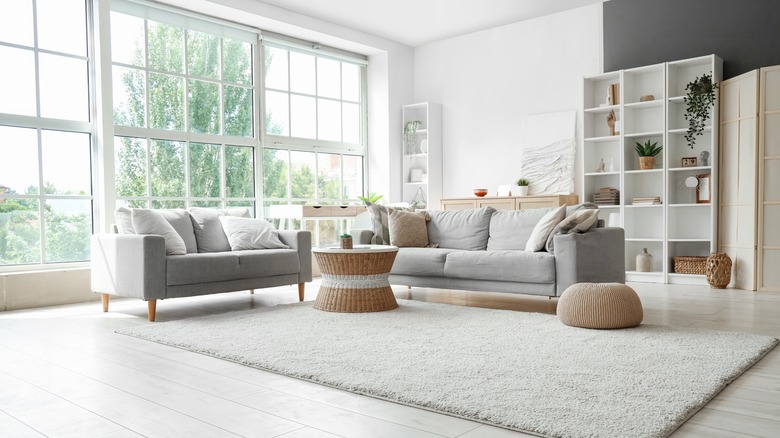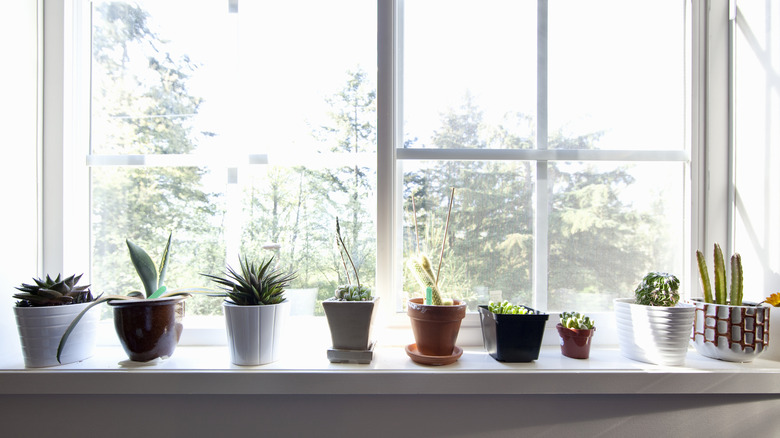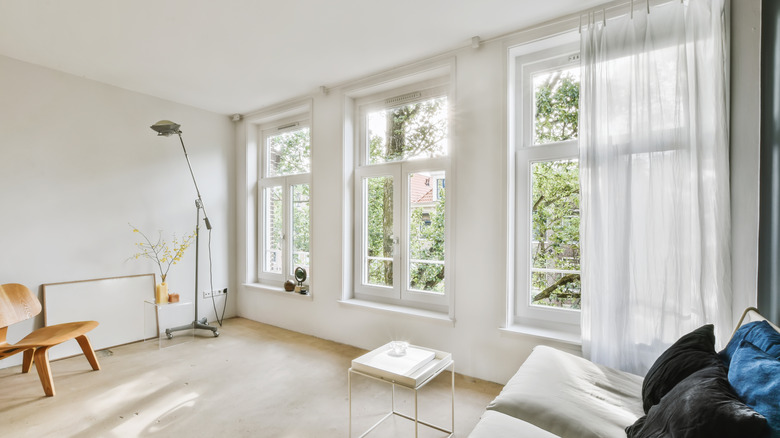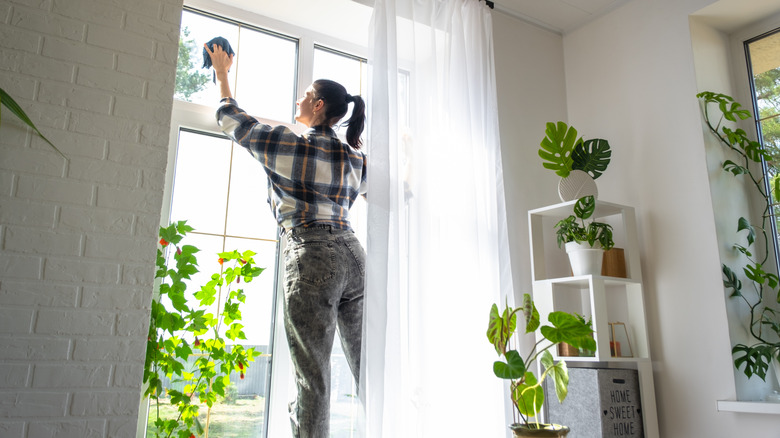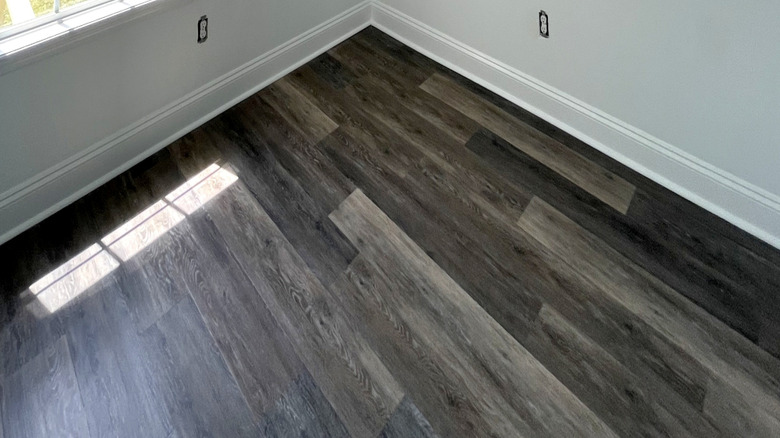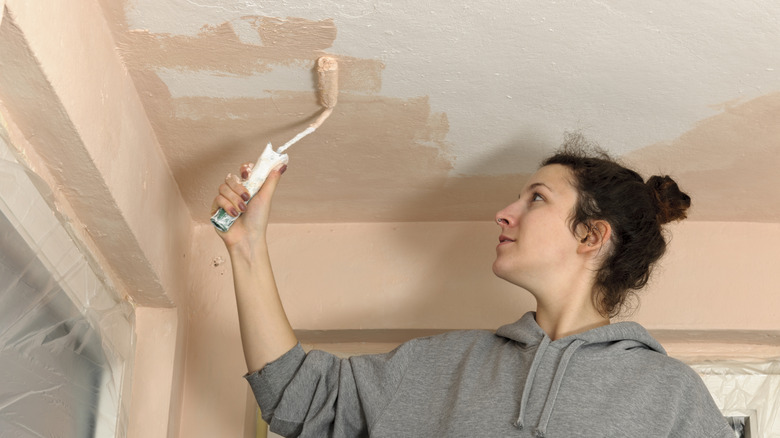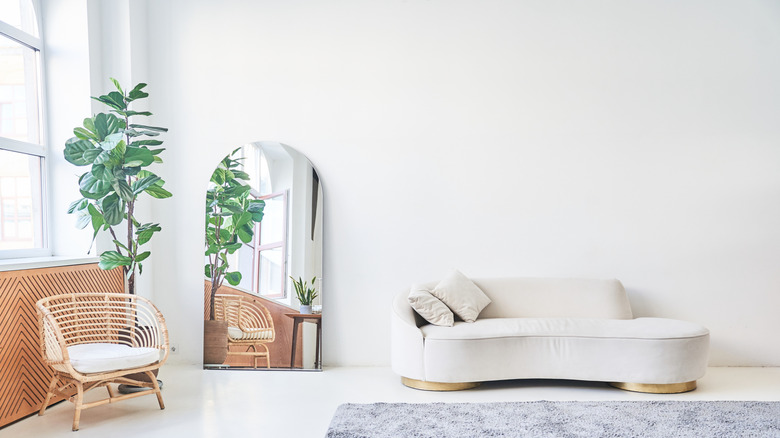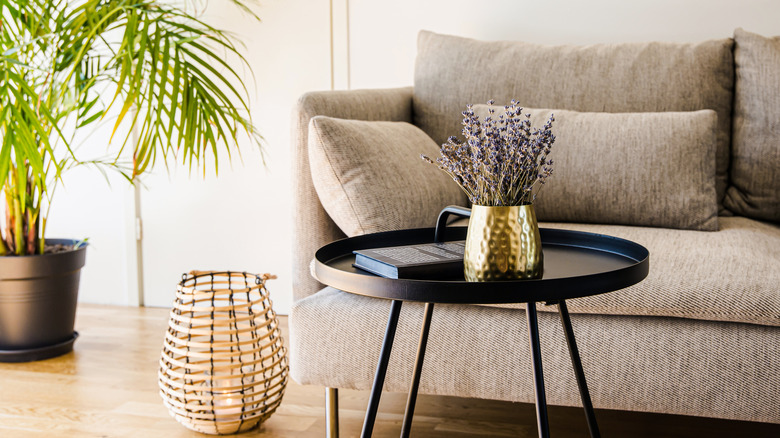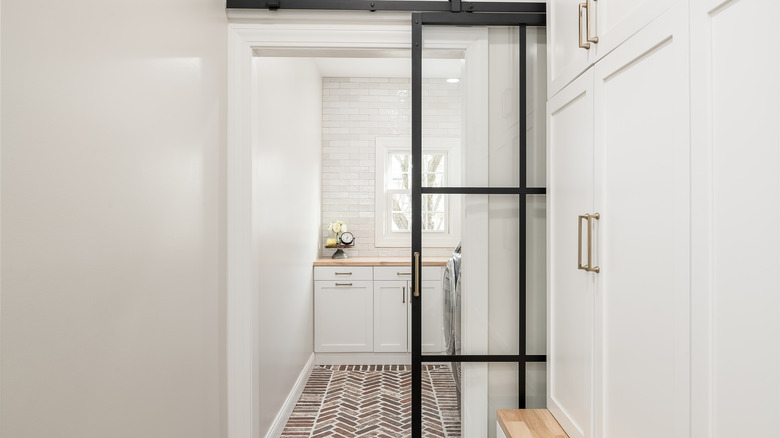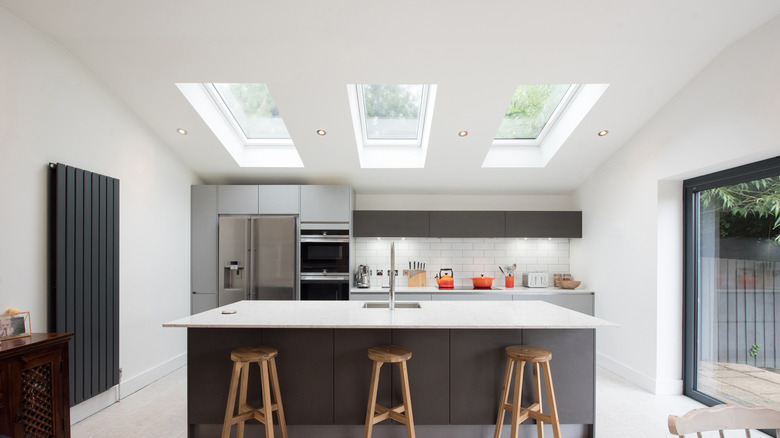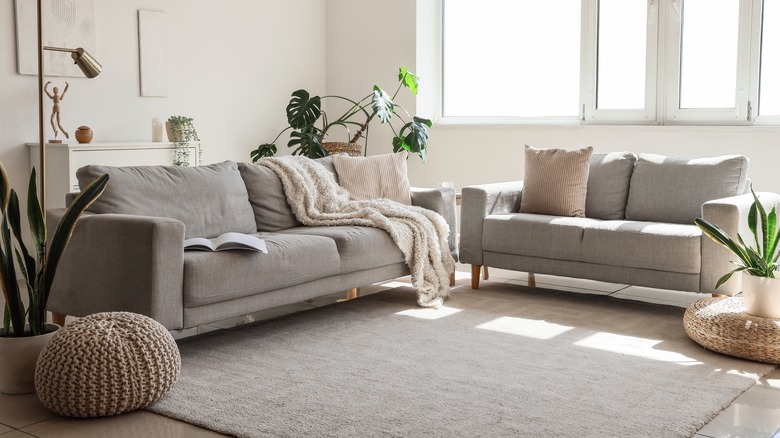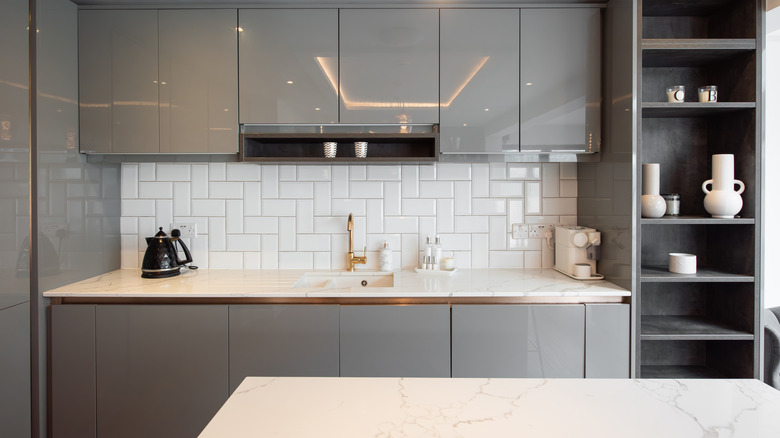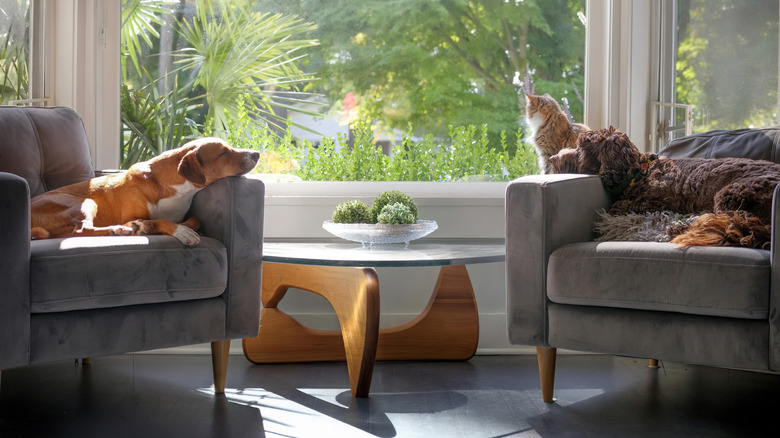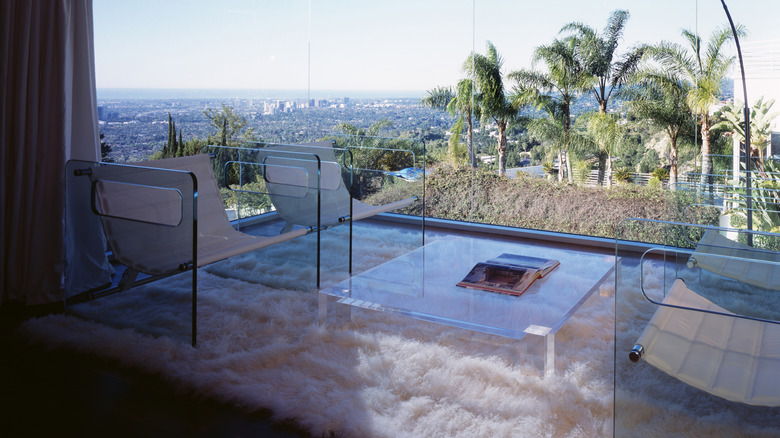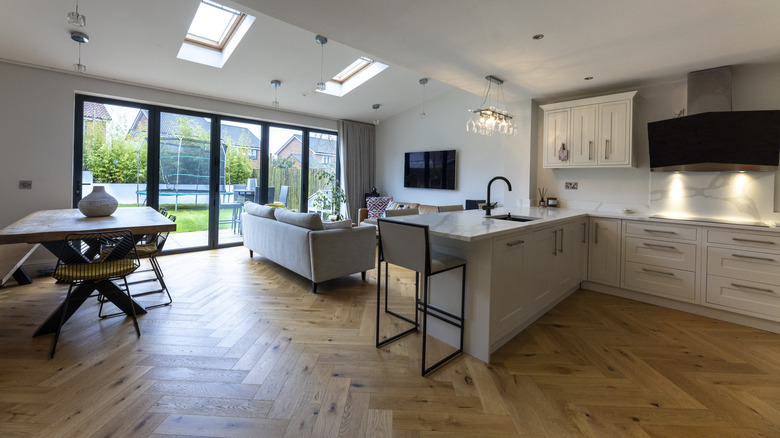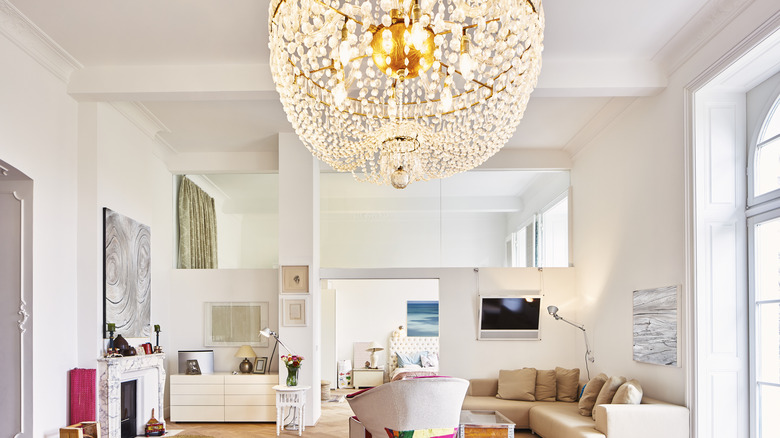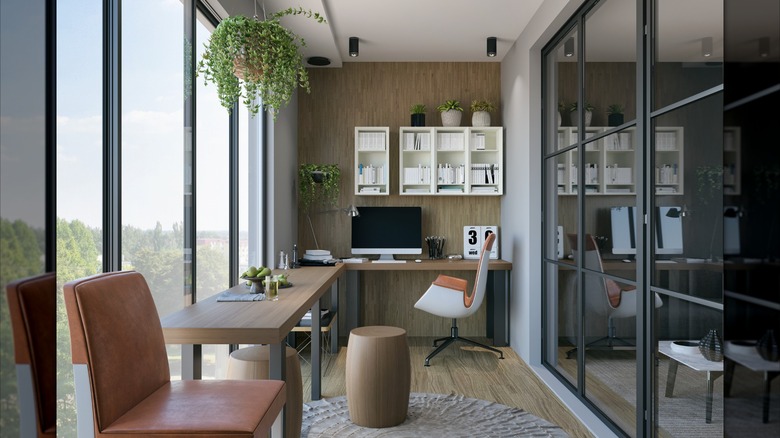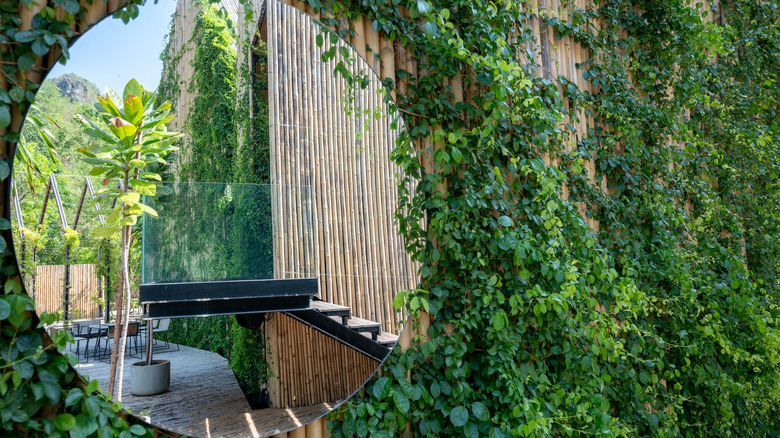The 25 Best Ways To Improve Natural Light In Your Home
Trying to lower your utility bills without living in the dark for the better part of a day? Capitalize on natural lighting to brighten every nook and cranny of your home. However, if you're having difficulty inviting daylight indoors, you can take control of the situation in a few ways. For instance, strategically placing mirrors near windows, bringing in lustrous decor items, and maintaining clean surfaces on these features will organically improve natural light in your house. But before you dive off the deep end, determine the way light flows in. To elaborate, check the rooms that receive a steady stream of direct sunlight, the spaces that get the watered-down version, and the areas that remain dim.
You also want to check whether your home is east-, west-, south-, or north-facing since this will determine the amount of light you'll receive when the sun is shining and the time of day when your home would be the brightest. East-facing windows will receive direct sunlight early in the morning, while the time approaching dusk is more favorable for west-facing windows. North and south remain illuminated the entire day but won't receive the sun's rays directly. Further, consider your lighting requirements in each room to employ a method that works for you best. Armed with this info, read on to find the 25 best ways you can improve natural light in your home.
Consider adding more windows to your home
The easiest way to bring in more daylight in your home is to add more windows to critical rooms that receive less sunshine, like your kitchen, bathroom, home office, and living room. Determine the sun's position relative to your house and install a window based on your light requirements. For instance, you'll want bright light to brighten your kitchen each morning, so an east-facing window will work best here. Similarly, north-facing windows offer indirect sunlight, won't heat up a room, and keep shadows to a minimum, making them ideal for your home office. However, this is also an expensive option, with installation typically costing thousands of dollars.
Turn your windows into the center of attention in a room
In case you don't have the budget to install new windows in your home, give the ones you already have a royal treatment. While you may not be keen to turn your unassuming windows into the center of attention, this strategy will make you think there's more sunlight filtering in than possible. Dressing them up with attention-grabbing curtains (or other treatments), coloring them in pop shades, or placing non-obtrusive planted pots along the sill are two simple ways to achieve your goal. For a more dramatic effect, position a bench and other seating options beneath your windows.
Choose appropriate treatments for your windows
Another reason your windows won't filter in the required amount of natural light is the treatments you adorn them with. To illustrate, blackout curtains offer maximum privacy but keep the sunlight out, whereas sheer and semi-transparent curtains let light filter in even when drawn. On the other hand, roller and solar shades and pleated draperies let you control the amount of light you want in your home at any time. If privacy isn't paramount, you could ditch the treatments altogether. So, determine your needs and make a decision accordingly.
Keep your window panes shining
Your existing windows will only flood a room with sunlight if their panes are clean. This is especially true for picture and clerestory windows since you can't physically open the sash to soak in the sun's rays. So, schedule a bi-annual window cleaning session in your calendar to bring the exterior-facing to a shine and a monthly session for the interior-facing parts, or you'll have to settle in for a murky light. For streakless clean windows, grab this handy laundry tool. Alternatively, contact professionals, but be prepared to fork over more than $100 for one cleaning session.
Maintain your plant collection inside and out
Gazing at your blooming plants and sentinel-like trees from your window might be a habit for you. But overgrown vegetation will block your view and make it difficult for the sun's rays to reach inside your home. So, take note of the overgrown bushes, creeping vines, and tall trees outside your windows and give them a much-needed haircut to receive more natural light. Use the right tools and avoid common mistakes while pruning your plants. You also want to look at the potted plants lining your window sills and relocate the ones obstructing the flow of light indoors.
Keep the doors to your balcony and patio open
While windows are important to let natural light in, they aren't the only ones you can turn to. If you have a balcony, terrace, or patio in your home, try to leave the doors open during the day to brighten your dim interiors and bring in fresh air. As a bonus, you'll be enticed to enjoy the views outside. Avoid hanging a clothesline opposite the door, or your wet garments will soak in all the light, leaving you with shadows.
Paint your walls in a light shade
Although you might prefer dark shades for your walls, you must avoid them to maximize daylight in your house. Such colors greedily absorb light while their fairer contemporaries reflect it and turn your interiors brighter. For this reason, paint your walls in a light shade, like white, grays, pastels, and cool hues. To paint your home like a professional, find the position of the room and determine how sunlight hits the walls at different times during the day to make an informed choice. Paint one wall in a dark hue and others in a light shade to brighten rooms receiving minimal sunlight.
Pay attention to the paint's sheen
You might choose the paint colors for your room with great pain, but all your hard work will be for nothing if you settle on the wrong sheen. To elaborate, matte and flat finishes are a big no-no for rooms receiving limited natural light since they tend to eat up the light, making a room look smaller than it is. Moreover, high-gloss and semi-gloss paints reflect light and will light up a room. However, you'll have to deal with glare. Eggshell and satin, which are more subdued than glossy finishes, reflect light and don't give way to glares.
Reconsider the paint color for your ceilings
You might overlook the fifth wall while trying out different strategies to enjoy more sunlight indoors. However, that would be a mistake since your ceiling's paint color and finish will also affect the light in a room. Brushing on the same paint as your walls might not be the best approach for rooms receiving little light. Don't worry, though. You don't have to use white shades if you don't want to. The trick is to pick a shade that's lighter than your walls. Regarding the sheen, flat or matte are the best finishes for your ceiling, as they minimize glare from faux light sources.
Adorn your home with strategically-placed mirrors
An effortless way to enhance nature's light is to use this mirror trick to make your living room feel brighter. All you have to do is grab a mirror and position it facing your light-bearing windows or near them. This trick works for all kinds of light-receiving rooms since the reflective surface bounces back each ray of sunshine around a room, making it feel brighter. Play around with different mirror sizes and placements to reap greater benefits. Additionally, use more than one mirror to make a small room feel bigger than it is.
Settle on your decor accessories mindfully
Mirrors aren't the only decor item you can use to your advantage. Metallic or glossy decor accessories are equally impressive, as they, too, reflect light around a room and eliminate shadows. Arm yourself with metallic decorative pieces, like vases, picture frames, wall hangings, and other artwork, like sculptures, and position them mindfully to bounce nature's light around your home. The only caveat? Going overboard will turn your warm and cozy interiors into a showroom or robot convention venue. So, use glossy and metallic decorations in moderation, and don't shy away from unpolished decor.
Glass panels on doors will bring in more natural light
Don't let your solid doors keep out all the light. Install ones featuring glass inserts instead. These doors allow light to pass through the glass and illuminate your rooms, entryway, and interior hallways. Plus, they're available in a variety of styles, including hinged single, sliding, pivot, French, single folding, bi-fold, and stacker. So, you'll be spoilt for choices and can pick one that matches your home's aesthetic. Replacing your patio doors could prove beneficial, too. That being said, it's an expensive option, with a sliding glass door costing between $1,168 and $4,240.
Install a skylight or solar tube
Invite more daylight in your rooms with skylights. These ceiling windows will bring in nearly 30% more natural light than the windows on your walls. Simply put, this fixture will flood your interiors with light and make a room look bigger than it is. Plus, you get to work, sleep, and play under the stars without sacrificing any creature comforts you're used to. Win-win! Choose the right size and optimal location to make the most of this fixture. But be prepared to shell out between $1,008 and $2,774. Otherwise, get a solar tube, which might cost between $600 and $1,000.
Retire your dark carpets and flooring
If your floors feature dark carpets or other flooring in light-absorbing hues, replace them with light-colored ones because they bounce light around the room. Light-shaded hardwood floors, such as maple, ash, or white oak, are a few good options if you have your heart set on wood flooring. Tiles in whitish, gray, or cool hues work as well. Carpets and rugs favoring neutral shades and light colors will open up a room and maximize the daylight. Flooring sporting high- or semi-glossy finishes, like reflective laminates and natural stones, fit the bill, too.
Pick reflective tiles for backsplash around your home
A clever way to make your heavy traffic rooms, like the kitchen and bathroom, appear brighter is to choose the right backsplash. Glass tiles are a good option since they can bounce back around 100% of the light that hits them, making them an ideal choice for homes relying on both natural and artificial light. Additionally, they're sustainable and eco-friendly, and you're free to choose any kitchen backsplash color that tickles your fancy — yep, even the dark ones. Other reflective backsplash options include high-gloss ceramic and metallic tiles.
Ensure your furniture doesn't block the windows
A cozy chair with a high back in front of your windows might be your favorite spot to sit and read (or ruminate), but such furniture positioning could block light coming in from your windows. The same holds true for your bed frame and cabinets. To allow more light to stream in and illuminate your interiors, move away your furniture from the windows or choose ones with a low back. However, if that's not possible, a chair or couch taking up a few inches of the sill can work. Similarly, if repositioning isn't an option, maintain a few feet between the wall and the furniture.
Don't discount your furniture choices
Ideally, your furniture choices shouldn't block the windows, but this might not always be possible, especially if you don't have much room to reposition them or can't afford to leave a few feet between them and the wall. Under such circumstances, swap your solid light-absorbing furniture with transparent pieces, like acrylic or glass. Their glossy surfaces will allow light to pass through or bounce off them, illuminating the indoors naturally. Furniture frames with cut-out holes running through them, like a bed frame or chair, are another good choice for your home.
Light-hued fabrics enhance natural light indoors
Rearranging your furniture or opting for transparent ones will only get you so far. Pick light-colored fabrics over dark-hued ones to enhance natural light indoors. Besides soaking in light, dark fabrics also trap heat and make your home hotter during the warm months. So, always choose a neutral, light, or pastel-colored cover for your sofa and couch. You also want to choose light-colored fabrics for curtains. But before you dive off the deep end, experiment with a few shades to see how they fare against the light from your windows and if they give way to glares.
White and clean eaves will allow more light in
When was the last time you paid attention to your house's eaves and thought about their importance? If your answer is "never," you had better start paying attention to the overhang to increase the amount of daylight entering your home. A dark-colored eave will diminish the light hitting your windows and doors, negatively impacting the brightness. On the other hand, a light-colored eave (specifically white) will reflect the available light and send more your way. Maintaining and keeping them free of dust, debris, cobwebs, and critter nests is another way to enjoy more natural light.
Opt for an open floor plan if possible
Even though you may not be keen to let your guests view the mess on your countertops when they step into your living room or make it easier for your kid to focus on the TV while sitting on the dining table, an open-concept floor plan will bring in more natural light. The lack of barriers, aka walls, will allow the light from your windows, skylights, and balcony or patio uninhibited access to the entire room. Just keep the clutter to a minimum to improve your home's sight lines.
Use artificial lighting to your advantage
Even though you want to use the available sunlight during the day, you might have to use artificial lighting to your advantage in case you don't have a lot of windows or the budget to make any significant changes. But that doesn't mean you must let go of the ruse. Simply add LED bulbs that mimic natural light and offer a warm glow. Additionally, take a layered approach to ensure you have the light you need at any given point. You'll need task lighting for focused activities, ambient will illuminate the entire room, and accent will offer your prized decor a spotlight.
Invest in a stunning chandelier
Chandeliers are a good way to add a touch of luxury to your home while brightening it. But did you know these fixtures can also help enhance the natural light you receive? The only caveat is your chandelier should feature clear-cut crystals to put its refractive power to use. So, chandeliers made of wood or metal are a no-go. Additionally, keep in mind that a chandelier will only refract the light it receives, meaning sunlight should directly hit the fixture through skylights or clerestory windows. Otherwise, the effect wouldn't be noticeable.
Knock down solid internal walls
Solid internal walls can hinder the flow of light and make certain rooms appear darker than they would if they had access to the daylight flowing in from your windows. An easy fix would be to knock down solid internal walls and install glass or glazed panels instead. The panels will let light through while offering you privacy when required. Don't be afraid to play around with texture and tones to customize your walls — frosted glass will allow privacy, whereas transparent glass panels will brighten your entryway.
Add reflective outdoor features
Not all the magic can happen inside. Sometimes, you need to turn to your garden or yard to amplify the daylight flowing in. Simply put, reflective surfaces like mirrors will bounce more light your way and brighten any room directly in its path. Similarly, sunlight hitting outdoor water elements, such as ponds, bird baths, or fountains, will not only make these surfaces look glittering but also offer you more light. Glass pebbles, rocks, and stones will have a similar effect and prettify your outdoors. Reflective garden artwork made of metals will work, too.
Declutter and organize your home
Tall piles of clothes, a tower of takeout boxes, cardboard containers in a corner, teetering mounds of documents, and more will obstruct light from entering and saturating each corner of a room. The only way out is to take time from your busy schedule and declutter your home. Bonus advantage: the lack of mess will open up a room and make it feel more spacious. However, merely decluttering your rooms won't have a lasting impact if you don't organize your belongings well and live by Benjamin Franklin's quote, "A place for everything, everything in its place."
